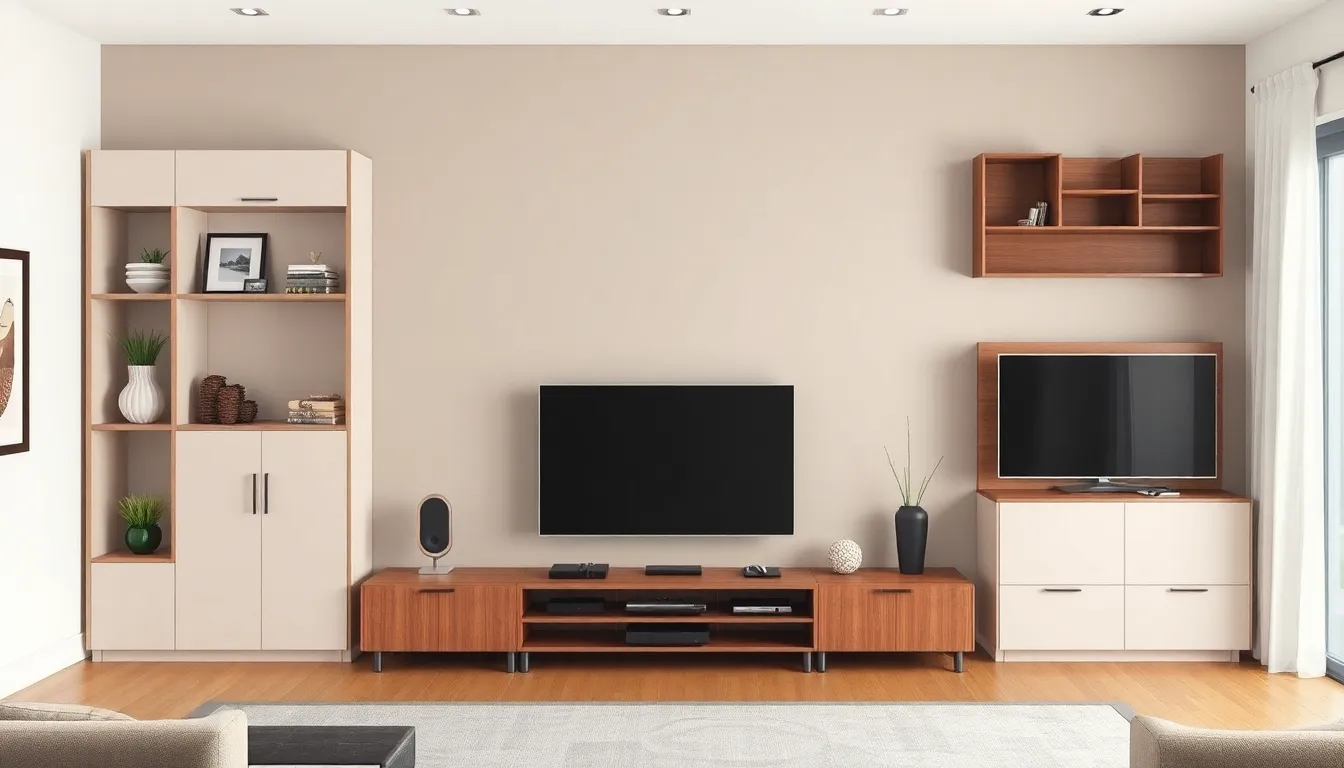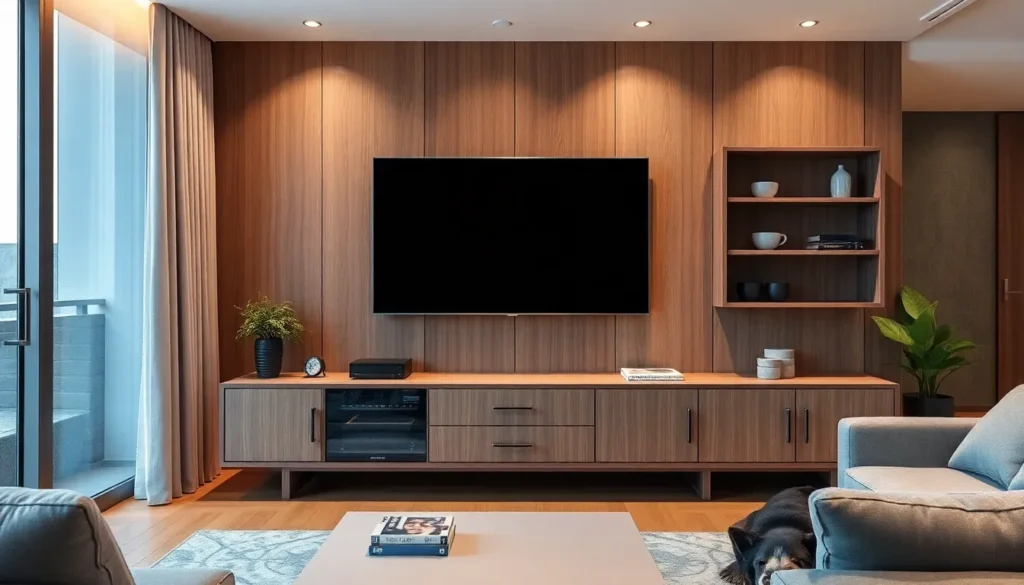In a world where binge-watching is practically a sport, the right TV furniture can elevate the experience from ordinary to extraordinary. Picture this: cozy evenings spent on the couch, snacks within arm’s reach, and a stylish entertainment center that makes your living room the envy of all your friends. It’s not just about where to place the remote; it’s about crafting a space that screams comfort and style.
TV furniture design isn’t just functional; it’s an art form that combines practicality with personality. From sleek modern stands to rustic wooden consoles, the options are endless. Choosing the right piece can transform a bland room into a vibrant hub for relaxation and entertainment. So, let’s dive into the world of TV furniture design and discover how to create a space that not only showcases your screen but also reflects your unique taste.
TV Furniture Design
TV furniture design plays a crucial role in defining a space. It combines utility and aesthetics, catering to both functionality and personal style.
Importance of Functionality
Functionality ranks high when choosing TV furniture. Storage solutions must accommodate various devices, including gaming consoles and streaming boxes. Easy cable management is essential for a clean look. Consider height and size; they significantly affect viewing experience. Adjustable shelves enhance versatility while allowing access to media equipment. Stability and durability ensure longevity, preventing accidents with heavier TVs. User-friendly designs make it simpler for anyone to adjust setups without hassle.
Aesthetic Considerations
Aesthetic considerations shape the overall ambiance. Style choices include modern, rustic, or traditional, appealing to diverse preferences. Material selection contributes to visual texture, whether opting for wood, metal, or glass. Color schemes should align with room decor, creating harmony in the environment. Customization options provide unique flair, allowing for personalized touches. Shapes and lines further influence the design’s flow, affecting how it integrates with other furniture. Thoughtfully designed TV furniture enhances both the space’s visual appeal and personal enjoyment.
Types of TV Furniture

Choosing the right type of TV furniture plays a significant role in maximizing both functionality and style within an entertainment space. Various designs cater to different preferences and needs.
Entertainment Centers
Entertainment centers serve as comprehensive hubs for multimedia equipment. Typically, these sizable units accommodate TVs of various sizes, storage for devices, and special compartments for gaming consoles and DVDs. Many designs also feature adjustable shelves, making it easier to customize the layout according to preferences. Considering their expansive surface area, users can display decorative items alongside technology without sacrificing organization.
TV Stands and Consoles
TV stands and consoles provide a more compact option for smaller spaces. They offer sufficient support for TV units while featuring ample storage for accessories such as remotes and gaming controllers. Bottom shelves or closed cabinets allow for discreet storage, minimizing clutter. Many styles range from contemporary to traditional, ensuring compatibility with existing furniture while providing a focal point for the room. Choosing a stand with cable management options enhances a tidy appearance, facilitating an enjoyable viewing experience.
Wall-Mounted Units
Wall-mounted units create a sleek and modern aesthetic. These space-saving designs elevate the TV and reduce the need for floor space while providing access to media storage. Floating shelves often accompany wall-mounted units, accommodating devices and decorative accents alike. This option allows for increased flexibility in room layout, positioning the TV at an optimal height for viewers. Selection varies from minimalistic styles to artistically designed pieces, perfectly blending function and elegance.
Materials Used in TV Furniture Design
Selecting materials for TV furniture design significantly impacts both aesthetics and functionality. Various materials, each offering unique benefits, cater to different stylistic preferences and practical needs.
Wood vs. Metal
Wood provides warmth and classic appeal, making it a popular choice for TV furniture. Many types of wood, such as oak, maple, or walnut, exhibit durability and versatility. Metal, on the other hand, brings an industrial edge and modern vibe to designs. Steel and aluminum are known for their strength and lightweight properties. Several furniture pieces combine both materials, leveraging wood’s richness and metal’s resilience. These combinations not only enhance structural integrity but also offer visual contrast, appealing to diverse tastes.
Glass Elements
Glass elements often elevate TV furniture by adding a sense of sophistication. Tempered glass shelves or cabinet doors create an open appearance, allowing decor items to shine while showcasing electronic devices. Glass also grants versatility, easily blending with both contemporary and traditional settings. Many designs incorporate glass as a visual element, enhancing aesthetic range without overwhelming space. Moreover, easy cleaning and maintenance further contribute to its practicality, making glass a favored option in modern TV furniture design.
Tips for Choosing the Right TV Furniture
Selecting the right TV furniture involves a few key considerations that enhance both functionality and style.
Size and Scale
Ensure the size of the TV furniture aligns with the television dimensions. Measure the space available and account for the furniture’s height, width, and depth. Avoid overcrowding the area, as it can lead to a cluttered look. Choose furniture that complements the proportions of the room, creating harmony in the space. A correctly sized unit not only accommodates the TV but also provides ample storage without overwhelming the environment. Evaluate the viewing distance; optimal distance depends on the TV size, ensuring comfort during extended viewing sessions.
Style Matching with Room Decor
Match the TV furniture style with existing room decor to create a cohesive aesthetic. Consider the overall theme; whether modern, traditional, or eclectic, the furniture should harmonize with other design elements. Utilize colors that complement the room’s palette, enhancing visual appeal while maintaining balance. Select materials that resonate with the surrounding furniture, promoting consistency throughout the space. Opt for unique features that express personal taste, like a distinct console or sleek stand, ensuring the TV area serves as a stylish focal point. Thoughtful design choice elevates the entertainment setup and enriches the overall atmosphere of the room.
Conclusion
Choosing the right TV furniture is essential for creating a space that balances style and functionality. Thoughtful design enhances the viewing experience while reflecting personal taste. Whether opting for a sleek wall-mounted unit or a classic wooden console, the right choice elevates the overall ambiance of the room.
Incorporating practical storage solutions and considering material selection plays a vital role in achieving a harmonious look. By aligning furniture with existing decor and ensuring it meets specific needs, individuals can transform their entertainment area into a stylish and inviting hub. Ultimately, well-designed TV furniture not only serves a purpose but also contributes to a more enjoyable and relaxing environment.

